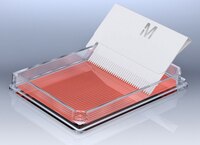17-10191 Sigma-AldrichCell Comb™ Scratch Assay
This Cell Comb Scratch Assay has been optimized to apply a high density field of scratches to maximize the area of wound edges, while leaving sufficient undamaged cells to migrate into the gap.
More>> This Cell Comb Scratch Assay has been optimized to apply a high density field of scratches to maximize the area of wound edges, while leaving sufficient undamaged cells to migrate into the gap. Less<<Recommended Products
Overview
| Replacement Information |
|---|
Key Specifications Table
| Key Applications |
|---|
| Invasion Assay, Migration, Cell Based Assays, ACT, Mass Spectrometry Sample Prep, WB |
| Description | |
|---|---|
| Catalogue Number | 17-10191 |
| Brand Family | Chemicon® |
| Trade Name |
|
| Description | Cell Comb™ Scratch Assay |
| Overview | Read our application note in Nature Methods! http://www.nature.com/app_notes/nmeth/2012/121004/pdf/an8416.pdf (Click Here!) Cell migration can be studied by a variety of methods, but the scratch assay remains a highly popular method due to the simplicity of the required materials, experimental setup, data collection and interpretation (Lian, C., et al., 2007; Cory, G., 2011). The scratch assay is typically initiated by scratching a confluent cell monolayer with a pipette tip to create a narrow wound-like gap. Shortly after wounding, the cells at the edge of the wound initiate a program to migrate into the gap, a process that continues until the gap has been completely repopulated with cells. Extent of wound closure is typically observed through light microscopy and protein expression patterns that occur during the wound healing process can be characterized by immunofluorescence. Advances in understanding the repair mechanisms of wounded cell monolayers have been facilitated by the development of methods for performing the assay in multiwell plates. Such methods include delivering wounds to existing monolayers in the wells, or occlusion of the center of the well during monolayer formation to create a gap (Yarrow, J.C., et al., 2004; Simpson K.J., et al., 2008; Gough, W., et al., 2011). Each method then involves quantification of the extent of cell migration into the gap. However, these methods are not optimal for biochemical analysis of the molecular events mediating wound repair. For example, the small scale of a basic pipette tip-derived wound provides insufficient and inadequate material for biochemical analysis. Using the same pipette tip to scratch a cell monolayer in a larger plate is tedious and irreproducible, and the proportion of migrating cells to quiescent cells is low. Several methods have been described to scale up the scratch assay by creating multiple wounds in cell monolayers but these methods require specialized tools (Turchi, L., et al., 2002; Lauder, H., et al., 1998). EMD Millipore has developed the Cell Comb™ Scratch Assay to address the need for an easy-to-use tool for creating multiple scratch wounds. The patent pending Cell Comb™ has been optimized to apply a high density field of scratches to maximize the area of wound edges, while leaving sufficient numbers of undamaged cells to migrate into the gap. This form of high density wounding creates a high proportion of migrating cells to quiescent monolayer cells, which permits sensitive detection of the biochemical events occurring, specifically in the migrating cell population. |
| Materials Required but Not Delivered | 1. Sterile cell culture hood 2. Pipettes, liquid aspirators, etc. for handling of cells and liquid reagents 3. Sterile plastic ware (cell culture flasks, centrifuge tubes, pipettes, pipette tips, etc. for handling of cells and liquid reagents) 4. Sterile Dulbecco’s phosphate-buffered saline (DPBS), without calcium or magnesium 5. Cell type of interest, with appropriate growth medium and cell detachment buffer (e.g., 0.25% trypsin) 6. Hemocytometer (e.g. Scepter™ Handheld Automated Cell Counter) 7. Trypan blue or equivalent viability stain 8. Low speed centrifuge for cell harvesting 9. CO2 tissue culture incubator 10. Cell lysis buffer, compatible with biochemical assay of interest 11. Cell scraper |
| References |
|---|
| Product Information | |
|---|---|
| Components |
|
| HS Code | 3926 90 90 |
| Quality Level | MQ100 |
| Biological Information |
|---|
| Physicochemical Information |
|---|
| Dimensions |
|---|
| Materials Information |
|---|
| Toxicological Information |
|---|
| Safety Information according to GHS |
|---|
| Safety Information |
|---|
| Storage and Shipping Information | |
|---|---|
| Storage Conditions | Store Cell Combs and Cell Culture Plates at room temperature. Use within 1 year from date of receipt. |
| Packaging Information | |
|---|---|
| Material Size | 6 assays (1 kit) |
| Material Package | Enough Materials to Perform 6 Scratch Assays |
| Transport Information |
|---|
| Supplemental Information |
|---|
| Specifications |
|---|
| Global Trade Item Number | |
|---|---|
| Catalog Number | GTIN |
| 17-10191 | 04053252689741 |
Documentation
Cell Comb™ Scratch Assay SDS
| Title |
|---|
User Guides
| Title |
|---|
| Cell Comb¿ Scratch Assay |
| Cell Comb™ Scratch Assay |












